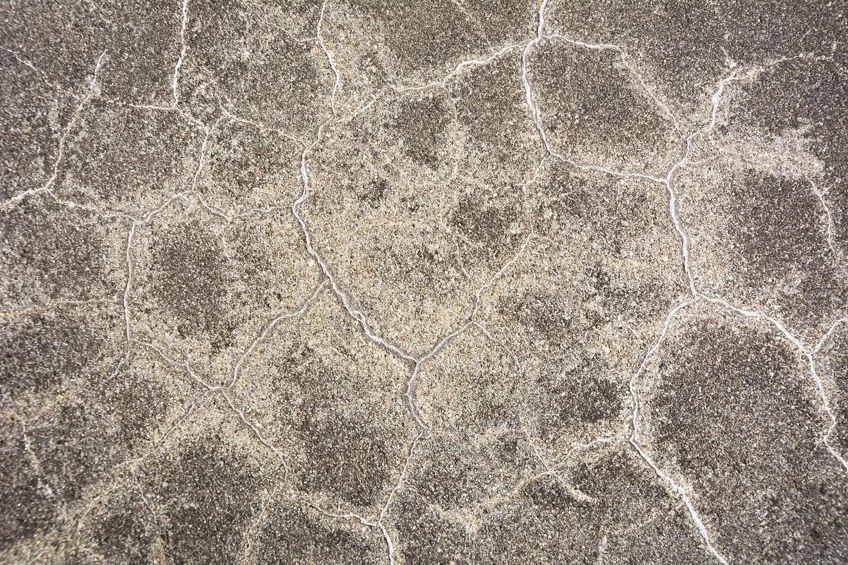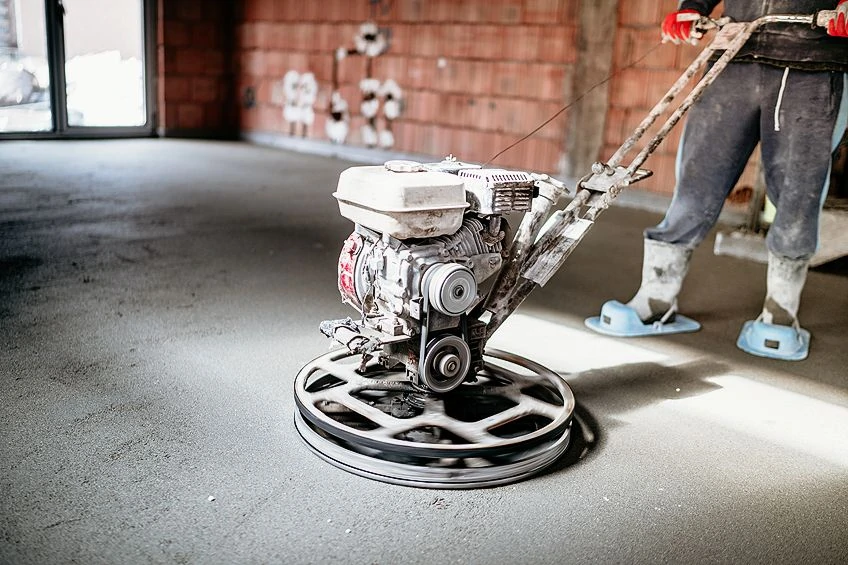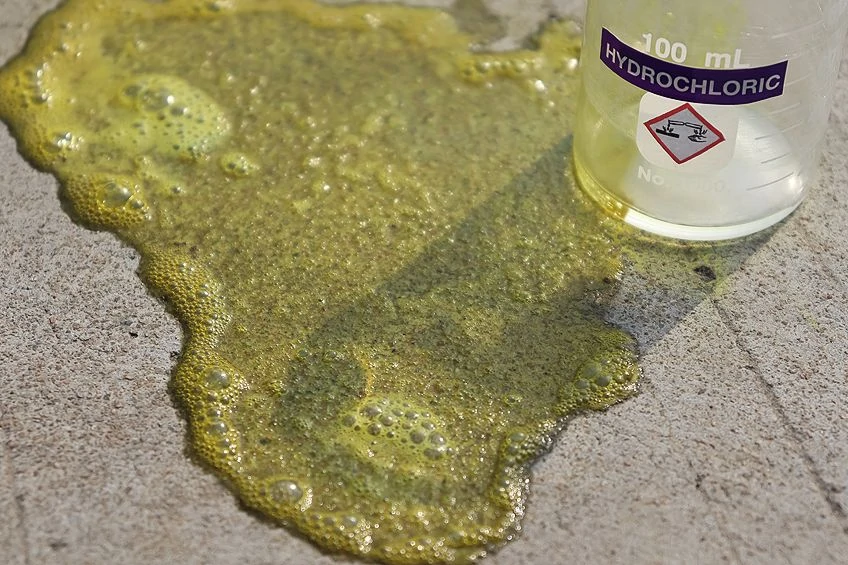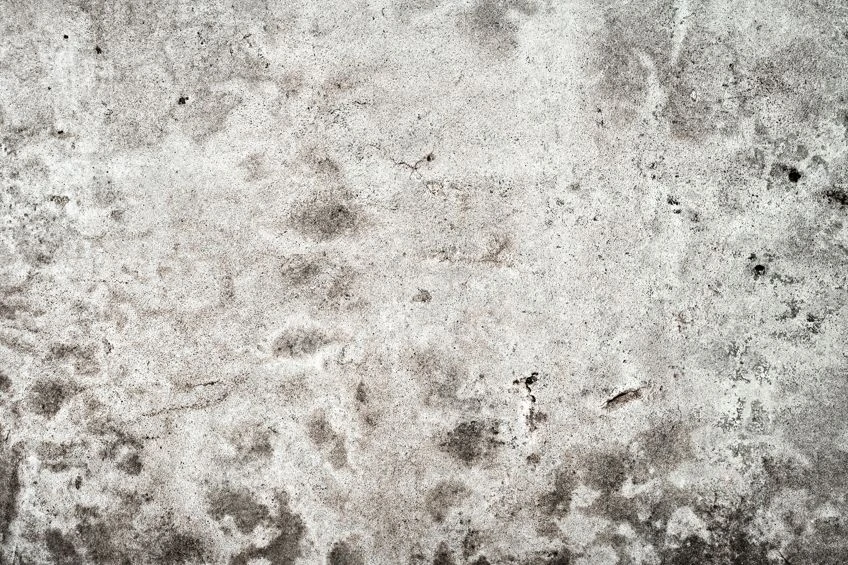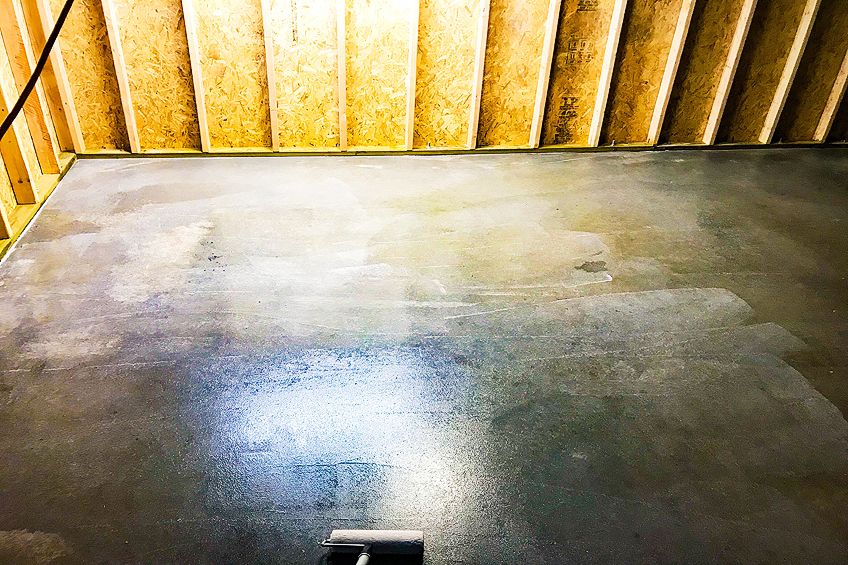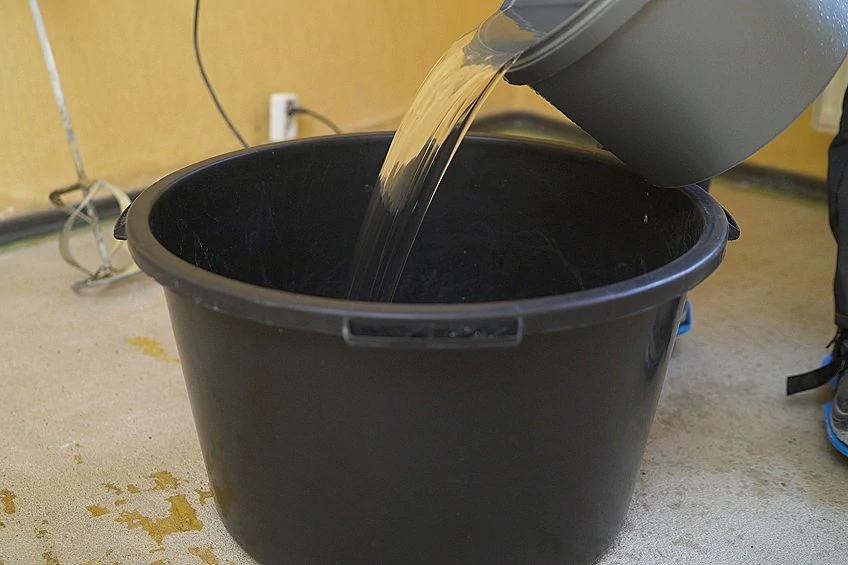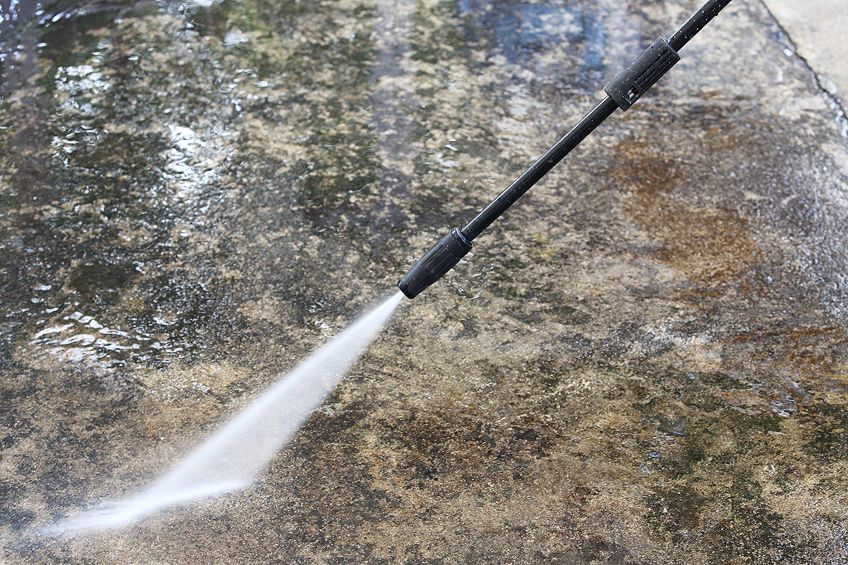Concrete Etching – A Complete Guide to Acid Etching Your Garage Floor
This post may contain affiliate links. We may earn a small commission from purchases made through them, at no additional cost to you. You help to support resin-expert.com
Are you planning to coat your garage floor yourself? To avoid disappointment it is best to prepare your concrete floor before you start painting, or you may end up with premature chipping or peeling of the new coating. Concrete etching is a great DIY option for preparing your surface, as it is far less labor-intensive than using an abrasive disc and grinder. However, we doneed to take precautions when dealing with possibly harmful chemicals. Read on for a comprehensive DIY guide to acid etching concrete with muriatic acid.
Table of Contents
Disclaimer
The information in this article is based on in-depth research into the topic and has been carefully and earnestly compiled. However, resin-expert.com will accept no liability for injuries to persons or damages to property that may occur. Choosing to work with the chemicals mentioned in this article is done so at the risk of the reader. Always follow the manufacturers instructions.
What Is Concrete Etching and Why Should I Do It?
Concrete etching is the process of applying an acid and water solution to a concrete floor in order to roughen the surface of the concrete. The acid wash opens pores in the concrete, which ensures strong adhesion of the new coating to its surface.
There are a few methods available, but acid washing your garage floor is the most cost-effective way to prepare a concrete surface. Along with creating a rougher texture for the coating to bite onto, it also neutralizes the alkalinity of the concrete, which further increases the bond of the coating to the concrete. Neglecting to prepare the concrete by using acid or mechanical means before coating it can lead to a poor paint bond that will not last.
Concrete Laitance
Laitance is a build-up of weak, powdery-type concrete particles on the surface of newly installed concrete. It is quite common and is due to too much water in the concrete mix. During the curing process, water rises to the surface and brings with it fine particles of concrete that will eventually dry onto the surface.
Thin layers of laitance can be removed by acid etching. If you decide to apply a coat of paint over laitance, there is a good chance that the coating will peel off, taking with it the layer of concrete laitance. Acid etching is a great way of removing thin layers of laitance before applying paint.
Concrete Efflorescence
Efflorescence is similar to laitance in that it is a build-up of chalk-like substances on newly installed concrete. Instead of containing sand and concrete particles, it contains salts. Efflorescence can provide a similar problem when it comes to the adhesion of a new coating, but etching with muriatic acid can remove this stubborn residue.
Acid Etching versus Grinding
While acid etching concrete is affordable and relatively easy to do yourself, hiring a coating specialist is the best option if it fits within your budget. A coating specialist will choose to prepare the surface of the concrete using mechanical means such as shot blasting, grinding, or dustless sanding.
These methods are ideal for surface profiling concrete as they provide a uniform result. The machines that are used are designed to collect the large amounts of dust that is created during the process. However, this option requires the involvement of experts and heavy machinery.
One could attempt to use a grinder and an abrasive disc to prepare concrete themselves, but this can be challenging to do correctly. Acid etching proves to be the best option for someone looking to prepare and coat concrete flooring themselves without the involvement of a professional. Below is a simplified comparison of acid etching and surface grinding.
Pros and Cons of Acid Etching
PROS
- Affordable
- DIY friendly
- Dust-free
CONS
- Toxic
Pros and Cons of Surface Grinding
PROS
- Non-Toxic
CONS
- Expensive
- Requires a skilled professional
- Creates excessive dust
Note: Whether grinding or etching, the preparation of concrete before coating a concrete floor is also referred to as surface profiling. Achieving the correct surface profile can make or break the bond of a new concrete coating.
Types of Acids for Etching Concrete
There are alternative products on the market that are specifically designed for etching concrete. Some of these are a blend of chemicals, including muriatic acid and phosphoric acid, and some contain very mild non-toxic acids. These specialized chemicals are a safer alternative to muriatic or hydrochloric acid as they give off fewer fumes, and the eco-friendliness of some products means that they do not require neutralization. However, they can be more expensive and some of them less effective. Let us take a look at the types of acids available for etching concrete.
Muriatic Acid
Muriatic acid is the most common and most effective acid used for etching concrete. Muriatic acid is an unrefined variant of hydrochloric acid, and can be identified by its yellow hue, which is due to its high iron content. It is a very powerful acid that is used to clean masonry of rust and excess mortar, but it can also eat away at fabrics and corrode most metals. It can burn skin and the noxious fumes can damage your lungs and nasal passages if inhaled.
This is why great care needs to be taken when working with muriatic acid.
Hydrochloric Acid
As well as being found in gastric acid – also known as stomach acid – hydrochloric acid is also used to process steel, treat swimming pools, and is used in the manufacturing of batteries. Hydrochloric acid can also be used in the etching of concrete. It is just as powerful as muriatic acid and therefore the same amount of care should be taken when handling it.
Phosphoric Acid
Phosphoric acid is a weak acid that is found in household cleaning detergents and is often used as a food additive. It is far safer to work with than muriatic acid and hydrochloric acid. The downside is that along with being less effective, it is not widely available and it is more expensive.
Citric Acid
Citric acid is found in citrus fruit and is widely used in the food manufacturing industry. Because it is a weak acid, it has a longer reaction time than muriatic acid or hydrochloric acid, which means that it takes longer to etch the surface of the concrete. Just like phosphoric acid, it is safe to use and less protective gear needs to be worn, although it does come at a higher price.
Recommended Concrete Etching Product
If you are looking for a hassle-free and safer option to the above-mentioned chemicals, Rust-Oleum’s Clean & Etch for concrete comes highly recommended. This is a specialized product that is designed for ease of use in DIY projects.
RUST-OLEUM Clean & Etch for Concrete
Rust-Oleum Clean & Etch is a product that is specifically designed to etch and clean concrete. From garage floors, driveways, basements, and patios, Rust-Oleum’s Clean & Etch offers a safe, two-in-one option that does not require you to neutralize any acid after etching. It is environmentally friendly and safe to use around plants and lawns. The formula does not contain dangerous chemicals or noxious fumes. One gallon of Rust-Oleum’s Clean & Etch will clean and etch up to 500 square feet of concrete.
- Prepares unsealed concrete floor surfaces for coatings and stains
- Free of odors and dangerous chemicals and needs no neutralizing
- Added cleaning properties ensure oil and grease spots are removed
PROS
- Environmentally friendly
- No noxious fumes or harmful chemicals
- Cleans, degreases, and etches all in one
- Neutralizes the pH of the concrete
- Does not damage lawns or plants
CONS
- Expensive in comparison to muriatic acid
- May not be as effective as muriatic acid
How to Etch Concrete
Etching concrete can be a daunting task. You can start by gathering the supplies that you will need and then follow the steps below. As long as you have all the supplies necessary and follow the safety precautions, you will be all set to begin etching concrete with muriatic acid.
Supplies and Protective Equipment Needed for Etching Concrete With Muriatic Acid
- Rubber gloves
- Rubber boots
- Safety goggles
- Respirator approved for use with fumes
- Broom for scrubbing acid solution
- 5-gallon plastic bucket
- Wooden stick for stirring
- 2-gallon plastic watering can with sprinkler head
- Hose with spray nozzle and water supply
- Muriatic acid
- Baking soda for neutralizing the acid
- pH test strips
Etching Concrete: The Process
What follows is a step-by-step tutorial on how to acid etch concrete with muriatic acid. Once you have gathered all the necessary supplies and safety gear, you will be ready to begin etching your garage floor. Be sure to read the tips and tricks at the end of this article on etching concrete successfully.
Preparing the Concrete for Acid Etching
Remove all equipment and furniture from the room. Anything that has to remain in the room needs to be covered with plastic sheeting to protect it from potential splashing of the acid. It is important to remove all dust, debris, oils, or dirt from the surface of the concrete before proceeding with the acid wash. A patch of oil or a bit of debris can act as an acid resistant that will stop the etching in that area, thus creating an uneven surface on the concrete.
Begin by sweeping the floor thoroughly and then use an industrial degreaser to remove any grime, dirt, or oil from the surface of the concrete. Once the surface has been cleaned, rinse the concrete thoroughly with a hose. You may want to repeat this process to make sure the concrete is free from contaminants. The concrete must be damp when you apply the acid solution, but there must be no puddles of water. If pools of water have formed in any areas, a large, clean sponge can be used to soak up the puddles.
Note: If there is a sealer, curing compound, or an old coating on the concrete, it will have to be removed by sanding or grinding away the surface first, or else the acid will not be effective.
Mixing of the Acid Solution
At this point, it is recommended that you put on rubber gloves, rubber boots, goggles, and a respirator. Caution: It is extremely important to add the acid to the water. Mixing it the other way around can cause a chemical reaction that could splash you with acid.
The recommended ratio is four parts water to one part acid. A stronger solution of 3:1 ratio is advised if the concrete is considerably hard or highly polished. If you are unsure, it is best to mix up a small batch of 5:1 acid solution and pour half a cup or so onto an area of the concrete. You should see a reaction immediately. Fizzing or bubbling is a sign that your solution is strong enough. If nothing happens, try a 4:1 ratio and, if it is still not reacting, then a 3:1 ratio should do the trick. Make sure that the solution is well mixed by gently stirring the solution with a wooden stick.
Applying the Acid Solution
Once you have mixed up your acid solution, it is time to begin acid etching concrete. Decant the acid solution into the watering can. The sprinkler nozzle will reduce any splash as you spread the solution around evenly. Use the broom to scrub the concrete with the acid solution.
The bubbling should stop after 15 to 30 minutes. During the etching process, do not allow the concrete to dry. Sprinkle water to any areas that start to dry. When the bubbling has calmed down noticeably, it means that the acid is no longer reacting. The concrete should now have taken on the appearance of medium-grit sandpaper. If it is still relatively smooth, the concrete should be rinsed and a fresh acid solution needs to be applied.
Note: Do not let the concrete dry before applying the acid solution. A damp floor acts as a buffer to prevent an uneven etch.
Neutralization
Some concrete etching acids will come with a neutralizer, but in the case that one is not supplied, you can mix your own quite easily. Make up a solution to neutralize the acid by mixing one cup of baking soda with one gallon of water. Use the watering can to evenly distribute the solution onto the concrete floor and neutralize the acid. It is best to leave the neutralizer to sit for at least 10 minutes before rinsing.
Rinse
Rinse the floor with a hose while scrubbing and sweeping away the water. The rinsing of the concrete is very important because once the concrete dries, the neutralizing solution can leave a white power residue called calcium carbonate, and this can compromise the bonding of the coating. Be prepared to repeat the rinsing process several times to rinse away all residue.
Dispose of the solution and rinse with water according to your local and national regulations. This may involve putting more baking soda into the collected water to ensure the neutralization of the acid before disposal. After the final rinse, you can pH test your wet floor by dabbing a pH test strip against the wet concrete, or by dipping it into the water from the final rinse. A neutral pH of 0.7 is ideal for maximum coating adhesion. A pH below 0.6 indicates excess acid, which means that you will need to neutralize and rinse the concrete again. Before coating the concrete floor, it is best to wait for it to dry completely – this can take a few days depending on the climate.
Tips and Tricks for Etching Concrete Successfully
- Using a high-pressure hose will lift stubborn grime and loose dirt from the concrete.
- Most people think that muriatic acid will break down grease and oil, but this is untrue. Using laundry detergent is a good way of degreasing and cleaning before etching concrete with muriatic acid.
- Testing small amounts of a weaker acid solution is a great way to avoid wasting muriatic acid as well as time.
- A wet vacuum cleaner is a great way to remove the neutralized acid solution from the concrete floor. Collecting the liquid in this manner allows for easier pH testing and disposal.
- After neutralizing the acid and rinsing, you can use Kleen Green or Simple Green’s multi-surface cleaner to give the concrete a thorough clean. Just be sure to rinse the concrete properly, as residual cleaner will stop coating from bonding properly.
- Having a premixed neutralizing solution handy before you begin mixing the acid solution is a good way to be prepared for neutralizing any unwanted spills.
- Too much acid etching can damage the concrete. Do not overdo it. A texture similar to medium-grit sandpaper is the goal.
- Test whether you have achieved a substantial surface profile after etching by putting a small amount of water onto the dry concrete. If it is immediately absorbed into the surface, you have achieved a good enough surface profile to accept the coating.
Additional Safety Tips for Dealing with Muriatic Acid
- If you pour water into the acid an exothermic reaction will take place in which the acid could thrust itself out of the container and onto you. It is very important to remember to add acid to the water and not the water to the acid.
- Be careful when pouring acid directly into an empty container, as the acid could splash upward.
- Muriatic acid should not be mixed with any other acids.
- Never mix muriatic acid in a metal container. Always use an acid-resistant container to mix the acid solution.
- Wear full-face protection as well as full-coverage clothing when dealing with muriatic acid.
- It is best to keep muriatic acid in the container it was purchased in.
- Be sure to have a water source nearby to wash skin if it accidentally comes into contact with muriatic acid. If the acid comes into contact with your skin, you should immediately flush the area with water and remove contaminated clothing.
- If muriatic acid fumes come into contact with your eyes, you should flush them out with water for 15 minutes and consult a medical professional.
- Seek fresh air and consult a doctor if acid fumes are accidentally inhaled.
View our Concrete Etching web story here.
Frequently Asked Questions
How Soon Can I Etch My Garage Floor After Fresh Concrete Has Been Installed?
You should wait 60 days before going ahead with an acid wash. Freshly poured concrete will take about 30 days to cure and a further 30 days for excess moisture to evaporate. The exact amount of time will of course depend on the weather and climate.
When Can I Start Coating My Garage Floor?
After completing the concrete etching process, allow the concrete to dry for two to three days before coating. Residual moisture on the concrete could prevent the coating from bonding to the surface. In cooler weather, this may take a little longer.
What Happens if I Do Not Prepare My Concrete Floor Before Coating?
By opening the pores with a strong acid or by sanding away the top layer, you provide a rough surface for the coating to bite onto. If this step is skipped, the coating will not last. After a little time, the coating will lift, chip, or peel right off the surface.
Can I Use a Grinder to Roughen the Surface of My Concrete Instead of Acid Etching?
Yes. Using a grinder is a great method for surface profiling concrete. However, it is very labor-intensive and there is a risk of damaging the surface of the concrete if the person doing the grinding is inexperienced. This process usually calls for a professional, which can be costly. Etching concrete with muriatic acid is by far the most cost-effective method.
How Dangerous Is Muriatic Acid?
If muriatic splashes onto you it can burn the skin severely. It can also cause blindness if it comes into contact with your eyes. It is because of this that one should always take safety precautions very seriously. Goggles, gloves and long sleeves, and a respirator will ensure your safety.


